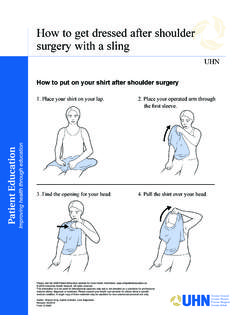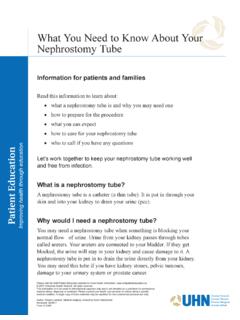Transcription of How to Self-Bandage Your Hand(s) and Arm(s) to Reduce ...
1 How to Self-Bandage Your Hand(s) and Arm(s) to Reduce LymphedemaFor patients with upper body lymphedema (swelling)who have had treatment for cancer (breast, melanoma, sarcoma, lymphoma) including: Surgery Removal of lymph nodes RadiationThis pamphlet explains: What is self-bandaging How does bandaging help with lymphedema When should I wear the bandages What should I do before I bandage How to bandage your fingers and armsDisclaimer: This pamphlet is for patients with lymphedema. It is only to be used after the patient and/or family member has been taught how to bandage by a clinician at the Princess Margaret Cancer Centre Lymphedema : D-86052Do not Self-Bandage if you have an infection in your fingers, hand, arm, trunk or chest:Signs of infection may include: Redness of the skin that expands or spreads.
2 Feeling of heat or warmth in the area that is red. An unexplained sudden increase of swelling in the area Pain in the area that is red. Raised skin around the area that is red. Fever or chills. Normal body temperature is: F or 37 C Feeling sick or you think you have an infection, go to: Your Family Doctor Walk in Clinic If no walk-in clinic is open, go to the closest hospital Emergency DepartmentIf you do have an infection, it is important to get medical help right away because infections can spread quickly. If you have an infection or other medical concerns, ask your health care professional if you should keep is the lymphatic system? Your lymphatic system removes extra fluid and waste from your body.
3 Your lymphatic system plays an important role in how your immune system works. Your lymphatic system is made up of lymph nodes that are linked by lymph lymph nodes are bean shaped organs that are found all over your body. Large groups of lymph nodes can be found in your neck, under your arms and in your groin (see picture to the right).Lymph nodes may be removed as part of cancer treatment. This can cause a type of swelling that is called Lymphatic System: Circles show where groups of lymph nodes are in your is self-bandaging?Self-bandaging is a way to help treat lymphedema (swelling). Self-bandaging is bandaging that you do by yourself or with the help of a family member or friend.
4 Self-bandaging includes layers of padding and bandages that are wrapped around the swollen area of your body to make a soft does bandaging help with lymphedema?If you had lymph nodes removed under your arm(s) and/or radiation treatment under your arm(s), breast, chest or trunk, the areas that may have swelling may include your finger(s), hand(s), arm(s), breast(s), and the swollen part of your body with bandages (compression), helps move the lymph fluid in the direction of the heart and away from your swollen goal of bandaging is to: Help Reduce the swelling Help prevent the swelling from getting worse Help soften firm, swollen tissueWhen should I wear the bandages?If you have lymphedema, you should: Wear your bandages during the day and when you exercise.
5 Wear your bandages for a few hours a day. Slowly increase the amount of time you wear them during the day. This will help you get used to wearing the bandages. Begin to wear your bandages at night after you feel comfortable wearing the bandages during the day. It is important that the bandages feel comfortable before you try sleeping in them all night. If you wear the bandages during the day and night, remember to take your bandages off each day to take care of your skin. Take a bath or shower and check your skin for cuts and areas of redness. Put moisturizer (lotion) on your skin. Remember to let the moisturizer soak into your skin completely before you bandage. If the bandages slip down or become loose, take the bandages off and re-wrap the bandages again.
6 It is normal for bandages to slip when you are moving. Be aware of your body. If the bandages become uncomfortable, try removing them and re-bandaging. If they are still uncomfortable after you re-bandage, contact the Princess Margaret Cancer Rehabilitation and Survivorship (CRS) at 416 946 4501 ext. should I do before I bandage? Clean your skin on your hand and fingers with soap and water and pat it dry. Make sure you dry between your fingers. Check your skin for any cuts or redness. If you have a cut on your arm, hand or fingers, clean the cut and apply a band-aid. The next time you take your bandages off, check to see if the cut is healing and there are no signs of infections (See page 2 for the signs of infection).
7 If the cut is still red, the area may be infected. Get medical help (See page 2). Put lotion on your skin. This will keep your skin moist and help avoid itchiness, irritation and blisters. Apply lotion to your arm and hand. Rub it into your skin so that your skin is moist but not sticky Pull on the stockinette (See image on page 8). It will prevent the lotion from rubbing sure you are in a comfortable position while bandaging to avoid any back or shoulder discomfort. A pillow under your arm or the support of a table top may be instructions given by the staff at the Cancer Rehabilitation and Survivorship (CRS) you lose your self-bandaging instructions, contact the CRS Clinic at 416 946 4501 ext.
8 2363. The clinic will mail or email you another all your supplies ready before you beginBandaging supplies may include: Stockinette (a thin tubular cotton layer) to protect the hand and arm Padding (fluffy white artiflex/castor padding or foam ) to help with pressure of the bandages Gauze (white, 4 cm and/or 6 cm) bandage for your fingers and thumb Short stretch bandages (beige) 6 cm, 8 cm or 10 cm Optional: adhesive (sticky) gauze for your fingers and thumb (See page 9)Ask for our booklet on How to Care for Your Bandages .How to Bandage Your Fingers and ArmsThere are 3 steps to follow:Step 1: Bandage your fingersStep 2: Wrap padding on your hand and armStep 3: Bandage your hand and armFluffy paddingShort stretchbandagesFoam paddingGauze for fingersStockinetteAdhesivegauze7 Step 1.
9 Bandage your fingers Put the stockinette on your arm. The stockinette will cover your hand but not your fingers and stop just below your underarm (about the size of 2 fingers wide below your underarm). Cut a small hole in the stockinette for your thumb. Pull the stockinette back over your hand and wrist to bandage your fingers and thumb. Wrap either 4 or 6 cm gauze loosley around your wrist. Wrap your thumb first. Bring the gauze up towards the bottom of your thumb nail. Start from the bottom of your thumb nail and wrap around your thumb two or three times towards the base of your thumb. Do not pull the gauze tight as you bandage your thumb and fingers. Wrap the gauze around your wrist kine tte8 Continue wrapping each finger the same way.
10 After you have wrapped all the fingers and thumb with gauze, wrap the base of each finger and thumb. You may have enough gauze left to do this or you may need to use another roll of gauze. Wrap the gauze around your wrist and bring the gauze around the base of your thumb and back around the wrist. This is a figure 8 pattern. Continue wrapping the base of each finger the same way. This will help secure the finger bandages. If you have any extra gauze, wrap it over the wrist and arm. Do not cut the gauze. Pull the stockinette back over your wrist and hand and put your thumb in the thumb hole you cut in step : Finger Wrap with adhesive (sticky, glue based) can use adhesive (sticky or glue-based) gauze to bandage your each finger and thumb on its own if you prefer.














